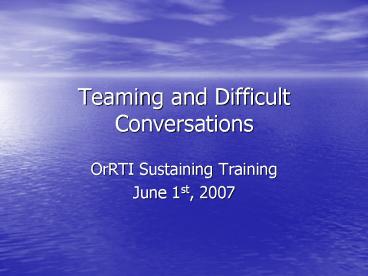Teaming and Difficult Conversations - PowerPoint PPT Presentation
1 / 11
Title:
Teaming and Difficult Conversations
Description:
Commitment Has your team identified its purpose? Does the team represent stakeholders in the school? Is there commitment to: The team itself? – PowerPoint PPT presentation
Number of Views:498
Avg rating:3.0/5.0
Title: Teaming and Difficult Conversations
1
Teaming and Difficult Conversations
- OrRTI Sustaining Training
- June 1st, 2007
2
Five Characteristics
Results
Accountable
Commitment
Conflict Capable
Trust
3
Trust
- What are issues that your team might encounter
that are based on trust.
4
Conflict Capable
- What experiences has your team had that have
tested your conflict capability? - What skills did someone use to address the
conflict?
5
Commitment
- Has your team identified its purpose?
- Does the team represent stakeholders in the
school? - Is there commitment to
- The team itself?
- To the teams purpose (children)?
6
Accountable
- Is there a clear agenda and purpose for each
meeting? - Is the role of each person defined?
- When preparation is required, is it complete for
the meeting? - Is there a mechanism for fixing accountability
problems? - Does the team take responsibility for maintaining
itself?
7
Results
- Does the team get to the core of its purpose and
evaluate outcomes? - Does the team encourage, plan, and celebrate
together?
8
How Teams Go South
- Meetings
- Communication
- Teamwork
- Decision-making
- Handling conflict
9
Critical Elements for Meetings
- Purpose
- Attention to structure
- Agenda
- Topic outcomes
- Content vs. process
- Clarity about meeting roles
- Meeting closure
10
Decision Making
- Know your desired outcomes
- Stakeholder buy-in, time frames
- Level of decision-making needed to reach desired
outcome - Frame problems broadly
- Set criteria for evaluating options
- Separate generating options from judging options
- Have back-up strategies if agreement is elusive
(for consensus decisions)
11
A communication strategy
- DARE
- Data (I notice. . .)
- Assumptions (I think it must be that. . .)
- Reaction (I feel. . .)
- Expectations (I bring this up so that. . .)

